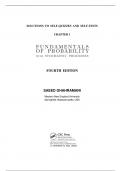SOLUTIONS TO SELF-QUIZZES AND SELF-TESTS
CHAPTER 1
FUNDAMENTALS
OF PROBABILITY
WITH STOCHASTIC PROCESSES
FOURTH EDITION
SAEED GHAHRAMANI
Western New England University
Springfield, Massachusetts, USA
A CHAPMAN & HALL BOOK
, Chapter 1 Solutions to Self-Quiz Problems 2
SOLUTIONS TO SELF-QUIZ PROBLEMS
Section 1.2
1. Suppose that jabk represents the order in which Jody is standing on the far left, Ann
next to Jody, Bill next to Ann, and Karl next to Bill. Define all other sample points
(possible outcomes) similarly. The event that, on the line, males and females alternate
is
E = {jbak, jkab, abjk, akjb, bjka, bakj, kjba, kabj}.
100
�
2. (a) E1E2 · · · E100. (b) E1 E2 · · · Ei−1 Eic Ei+1 · · · E100.
i=1
3.
(E ∪ F )(F ∪ G)(EG ∪ F c ) = (F ∪ E)(F ∪ G)(EG ∪ F c )
= (F ∪ EG)(EG ∪ F c )
= (EG ∪ F )(EG ∪ F c )
= EG ∪ F F c = EG ∪ ∅ = EG.
4. The event that a signal fed to the input is transmitted to the output is
F = E1 E2 E4 E7 ∪ E1 E2 E5 E6 E7 ∪ E1 E3 E5 E6 E7 ∪ E1 E3 E4 E7 .
Section 1.4
1. The desired probability is
� �
P (Ac B c ) = 1−P A∪B = 1−P (A)−P (B)+P (AB) = 1−1/3−1/4+0 = 5/12.
2. Let A be the event that Zack reads the book assigned on the given period. Let B
be the event that he completes his philosophy paper on or before the deadline. The
probability that he ends up meeting the deadline only for one assignment is
� �
P (A ∪ B) − AB = P (A ∪ B) − P (AB) = 0.95 − 0.6 = 0.35.
Note that this equality holds since AB ⊆ A ∪ B.
3. Let F , E, and I be the events that a randomly selected American traveler to Europe
travels to France, Englad, and Italy, respectively. We have
� �
P F ∪ E ∪ I = P (F ) + P (E) + P (I) − P (F E) − P (F I) − P (EI) + P (EF I).
Therefore,
2 1 1 1 1 1 1
= + + − − − + P (EF I).
3 3 2 4 5 5 5
This gives that P (EF I) = 11/60.
, Chapter 1 Solutions to Self-Quiz Problems 3
Section 1.7
1. No, it does not! In the experiment of choosing a random point from the interval
(0, 1), let A be the event that the outcome is either 1/3 or 1/2, and B be the event that
the outcome is either 1/5 or 1/3. Then
� AB� = {1/3}. So A and B are not mutually
exclusive. However, P (AB) = P {1/3} = 0.
2. For the experiment of choosing a point at random from the interval [0, 1], let E n =
�1 1 1 2 �
− , + , n ≥ 1. Applying the Continuity of Probability Function
3 n+2 3 n+2
to
En ’s, show that P (1/3 is selected) = 0.
, Chapter 1 Solutions to Self-Test Problems 4
SOLUTIONS TO SELF-TEST PROBLEMS
1. (a) By symmetry, the probability that Crispin ends up paying for dinner is 1/3.
(b) The sample space for one round of flips is
S = HHT, HTH, HTT, HHH, THT, TTH, THH, TTT .
The probability that no more than one round of flips is necessary is equal to the
probability that HHH and TTT do not occur in the first round, which is 6/8 = 3/4.
2. Let x1, x2, x3, x4 , and x5 be the production level, in hundreds, for baseballs, tennis
balls, softballs, basketballs, and soccer balls, respectively. A sample space for the
production levels of these balls by this manufacturer is
S = (x1 , x2 , . . . , x5) : 8 ≤ xi ≤ 13, 1 ≤ i ≤ 5 .
The event that on this day, the difference between the number of baseballs and soccer
balls produced will exceed 100 is
E = (x1 , x2, . . . , x5 ) ∈ S : |x1 − x5 | ≤ 1
= (x1 , x2, . . . , x5 ) ∈ S : x5 − 1 ≤ x1 ≤ x5 + 1 .
3. (a) The sample space is
S = {A1 A2 A3 , Ac1 A2 A3 , A1 Ac2 A3 , A1 A2 Ac3 , Ac1 Ac2 A3 , Ac1 A2 Ac3 , A1 Ac2 Ac3 , Ac1 Ac2 Ac3 }.
(b) The event that the system is not operative at the random time is
E = {Ac1 A2 A3 , A1 Ac2 A3 , A1 A2 Ac3 , Ac1 Ac2 A3 , Ac1 A2 Ac3 , A1 Ac2 Ac3 , Ac1 Ac2 Ac3 }.
4. Let A be the event that a randomly selected person from the given age group at this
geographic area suffers from Parkinson’s disease. Let B be the even that he or she
suffers from Alzheimer’s disease. The desired probability is
� �
P (Ac B c ) = 1 − P A ∪ B = 1 − P (A) + P (B) − P (AB)
= 1 − (0.134 + 0.113 − 0.0226) = 0.7756.
This shows that 77.56% of the people in the given age group in the given geographic
area have neither of the two diseases.
� �
5. We have that E cF = E ∪ F − E and E ⊆ E ∪ F . So
� � � �
P E cF = P E ∪F −P (E) = 1−P (E c F c ) −P (E) = (1−0.35)−0.4 = 0.25.
� �c
Note that by DeMorgan’s first law, E ∪ F = E cF c .




